Buried down one of the many alleys that make up the back streets of Insadong is a quaint little tea house that appears almost forgotten.Its exterior is not particularly impressive, nor does it do much to advertise itself; it’s not until you are standing in front of the entrance that you notice the small wooden sign that reads “신옛찻집” – Shin Old Tea House.
Shin Old Tea House in Seoul, Korea
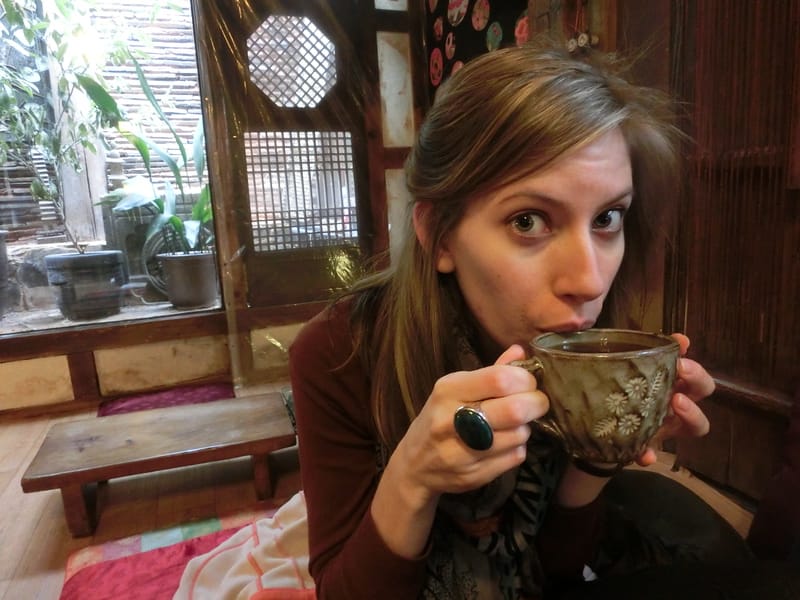
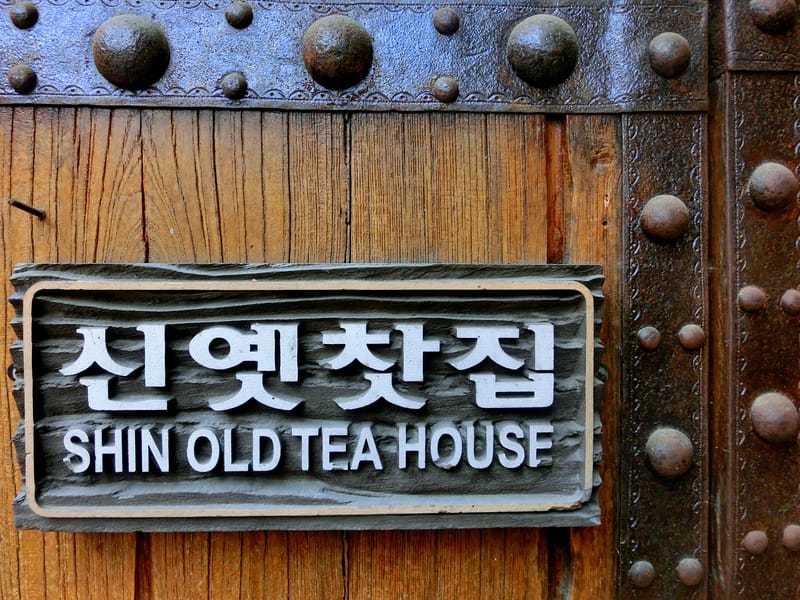
I pull the door open and a bell alerts the shop owner that two customers have arrived. The sweet ajumma smiles at us, her only guests on this chilly afternoon, and invites us to take off our shoes. We leave them on the concrete ground and step up unto the creaky wooden floors.
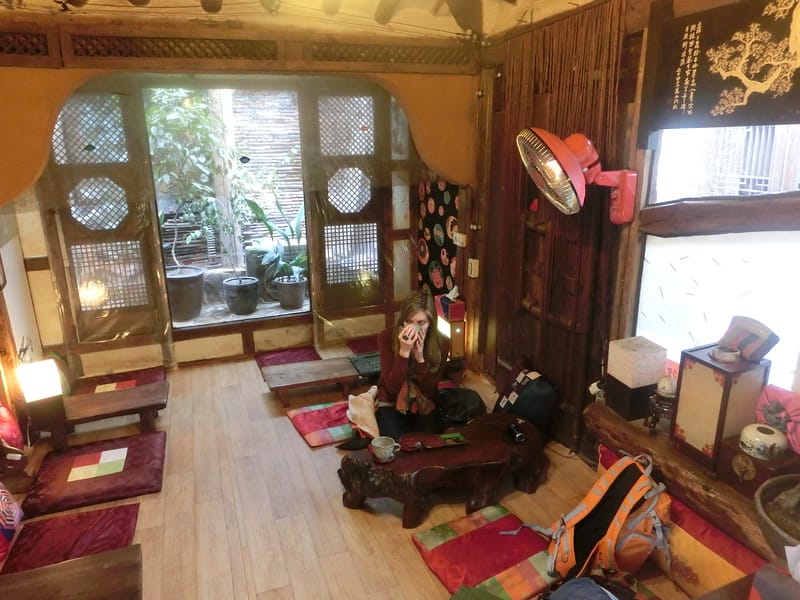
Inside it is a warm repose from Seoul’s wintry streets.
We plop ourselves down on bright silk pillows in front of a rustic table that sits just a few inches off the ground.
My eyes wander in all directions: colourful tapestries, ceramic teapots, a goldfish swimming in a tank, a large wooden chest, hanging lamps, beaded space dividers, a quirky frog sculpture, and more pillows and more knick-knacks.
Between the dim lighting and the heated floors, it’s difficult not to sink back into the cozy space.
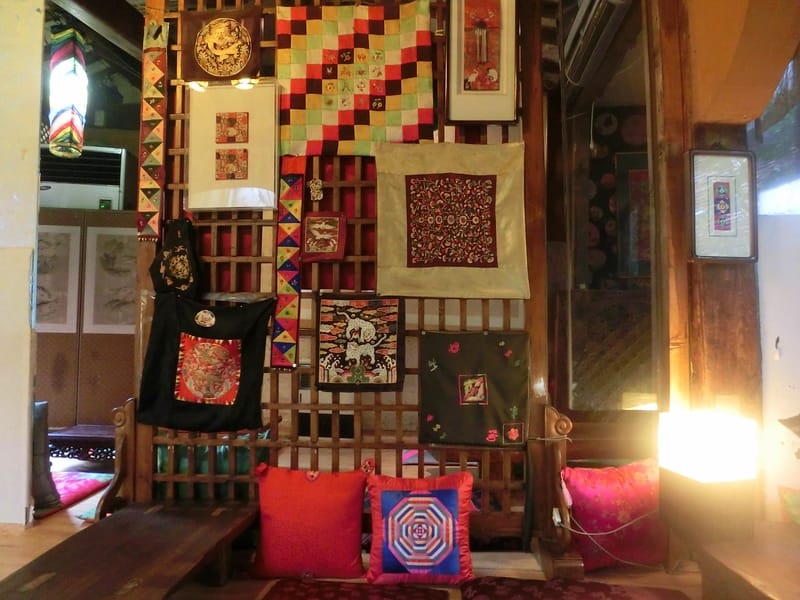
While I’m still gazing at my surroundings and making mental notes of wallpaper designs and pillow patterns, the ajumma returns with a menu.
Ice teas and hot teas, citrous and sweet – each item listed sounds more enticing than the next.
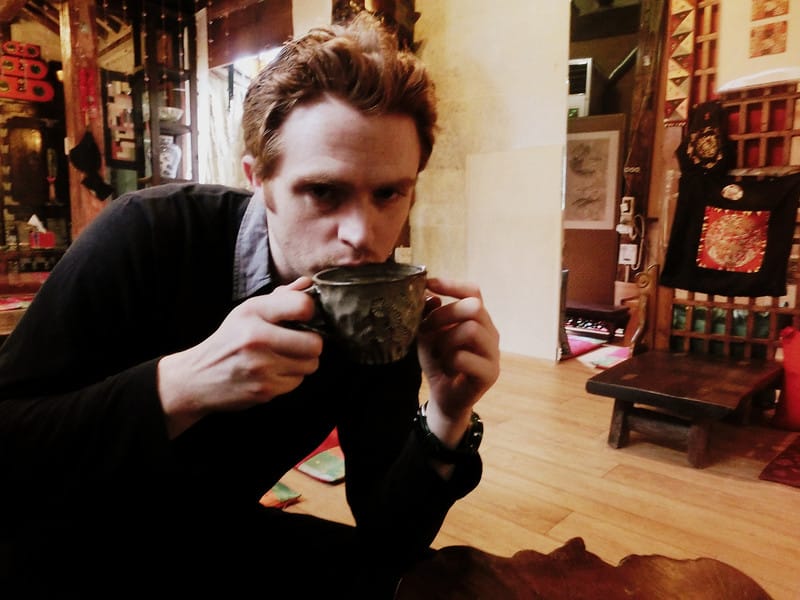
What We Ordered At The Traditional Korean Teahouse in Insadong
I order the plum tea off the menu, and Sam opts for the ginger tea.
Our sweet beverages are accompanied by sticky rice cakes and puffed rice. I haven’t enjoyed a single rice cake I’ve tried over the course of my year in Korea, but somehow paired with my sweet plum tea the combination is just right.
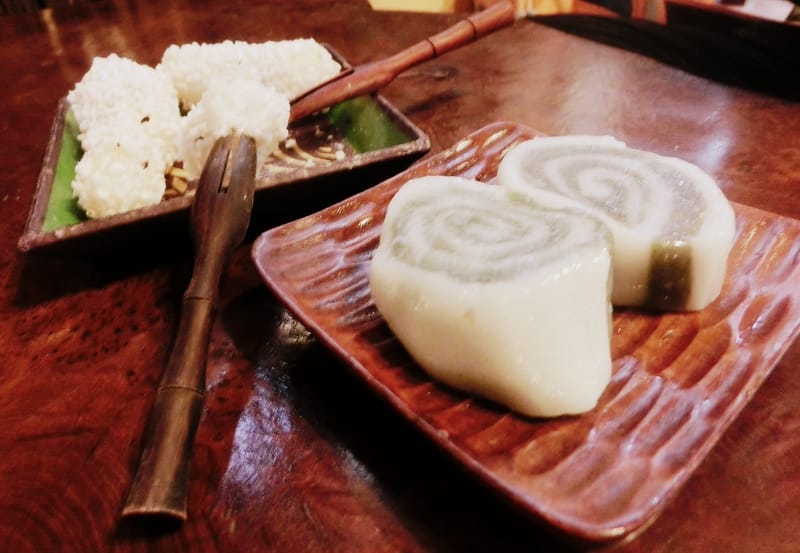
The ambiance is so serene that I find myself whispering and trying to laugh quietly even though no one is listening to us and there is no one to disrupt.
This is our second last weekend in Seoul and it feels nice to be doing something traditional yet low-key.
Sipping on our teas we reminisce about the past few months together, while plotting the adventures that await us in Malaysia in just a week’s time. This little Korean tea house is the perfect place to end our time in Korea.
Just a street away Insadong’s main strip is buzzing with activity, but seated in this cozy little tea house I feel like I am miles away.
Sometimes a neighbourhood’s best kept secret lies not too far off the trodden path.
Everything You Need to Know Before Visiting Shin Old Tea House
Here’s a deeper look at Korea’s tea culture, ordering etiquette and a few practical pointers that will help you savour each sip.
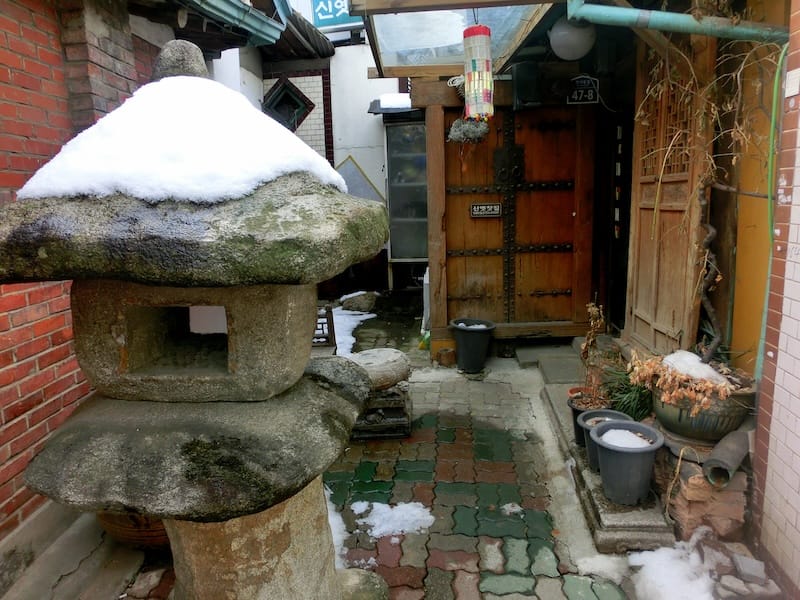
The Tiny History Behind a Modest Wooden Sign
Many travellers assume Shin Old Tea House is a clever modern reconstruction. But the building itself predates the tea room by several decades. The hanok started life as a seonang-dang (a shamanic guardian-spirit house) on the edge of a ginkgo grove that once belonged to a local calligrapher. When Seoul’s post-war boom swallowed the grove, the owner’s granddaughter converted the cabin into a teahouse where her art-college friends could gather, sketch and recite poetry. She named it Shin—meaning “new” or “to believe,” depending on the hanja—because she hoped the space would inspire fresh ideas while keeping faith with Korea’s disappearing folk traditions.
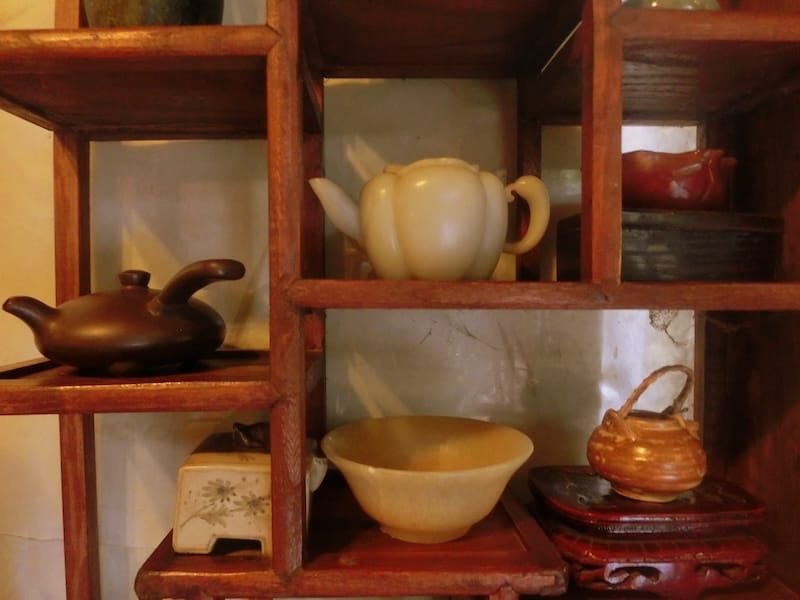
Decoding the Menu: Five Signature Teas Worth a Try
The laminated English list captures only part of the story, so here are a few drinks to keep on your radar:
| Korean Name | What It Is | Flavour Profile | Why Locals Order It |
|---|---|---|---|
| Maesil-cha (매실차) | Fermented green plum concentrate diluted with hot water | Honeyed apricot, subtle tartness | Aids digestion after a heavy meal of samgyeopsal or fried street snacks. |
| Saeng-gang-cha (생강차) | Slow-simmered ginger root with jujube slices | Spicy warmth, hint of caramel | The go-to cold-buster—grandmothers insist one cup keeps winter flu away. |
| Ssanghwa-cha (쌍화차) | Herbal decoction of angelica, cinnamon, liquorice; topped with pine nuts and egg yolk | Medicinal, earthy, mildly sweet | Traditional stamina booster for students pulling exam all-nighters. |
| Omija-cha (오미자차) | Dried “five-flavour” berries steeped overnight | Sweet, sour, bitter, salty, pungent | Served chilled in summer; changes colour if you squeeze lime into it—Instagram magic! |
| Hyeonmi-nokcha (현미녹차) | Roasted brown rice blended with green tea | Toasty popcorn aroma, grassy finish | Easiest transition for travellers who find straight nokcha too astringent. |
Tip: if you can’t decide, ask the ajumma for a ban-ban—half serve of two teas in smaller bowls. She’ll smile at the foreigner who knows the loophole.
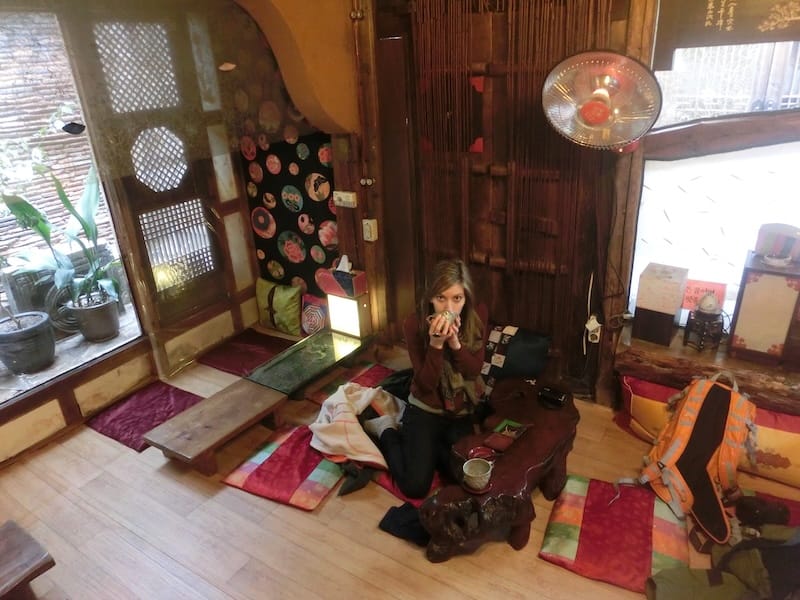
Etiquette 101: How to Sip Like a Seoullite
Shoes off, socks on – Holes in your heel? No judgement, but pack a spare pair if you plan a photo op.
Lower your volume – Conversation in a tea room is pitched at gentle subway-carriage levels. If you need to FaceTime home, step outside first.
Two-handed pour – When topping up a friend’s cup, hold the teapot with your right hand and support your forearm or wrist with your left. It’s a small nod of respect.
Leave a few grains – If you nibble the complimentary yakgwa (honey biscuits) or rice cakes, tradition says not to polish the plate; a crumb shows you’re satiated.
Pay at the antique till – Instead of signalling for the bill, walk to the chest near the entrance; each drawer slides out to reveal a guest ledger and bamboo pen.
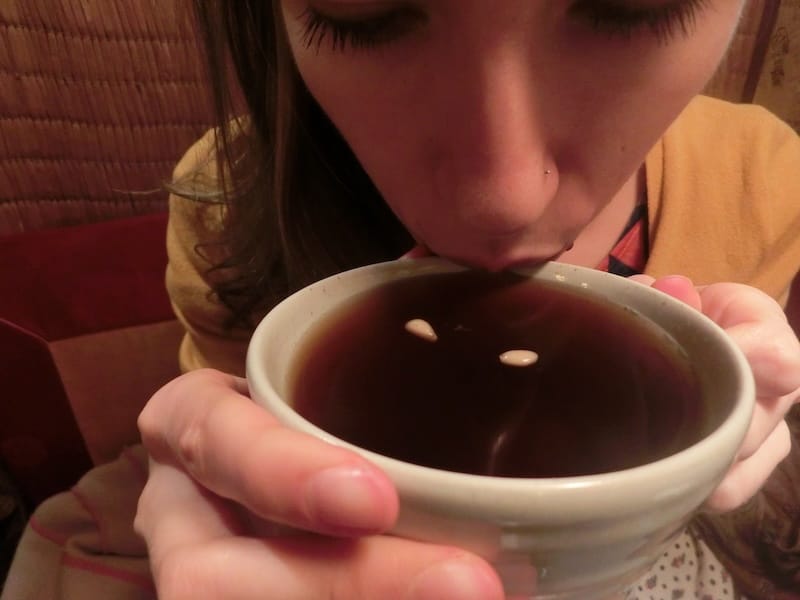
Planning Your Visit
| Detail | Insider Advice |
|---|---|
| Location | Insadong-gil 33, then right into the second alley after Ssamziegil; look for a faded blue postbox. |
| Nearest Subway | Anguk Station (Line 3) Exit 6; 6-minute walk. |
| Opening Hours | 11:00 a.m. – 9:00 p.m. daily; last order 8:15 p.m. Closed the first Monday of each month for Kimchi Day. |
| Price Range | ₩8 000–₩12 000 per tea; pots are refillable with hot water on request. |
| Card vs. Cash | They accept international credit cards, but a cash tip (₩1 000 coins in the bamboo box) is appreciated. |
| Best Time | Weekday mornings; after 4 p.m. weekends you may queue 10–20 minutes. |
Pairing Your Tea House Stop With Nearby Gems
Making a half-day of Insadong? Try this mellow loop:
11:00 a.m. – Browse antique ink stones at Tongmungwan, Korea’s oldest bookshop (est. 1907).
Noon – Slide down the basement stairs of Jirisan Restaurant for a vegetarian mountain-herb lunch set.
1:30 – Sip maesil-cha at Shin Old Tea House while the post-lunch lull settles.
3:00 – Walk to Kyung-In Museum of Fine Art; the admission ticket includes access to their courtyard persimmon trees.
4:15 – End with a street-food grazing session—honeycombed hotteok and dragon-beard candy—on the main strip.
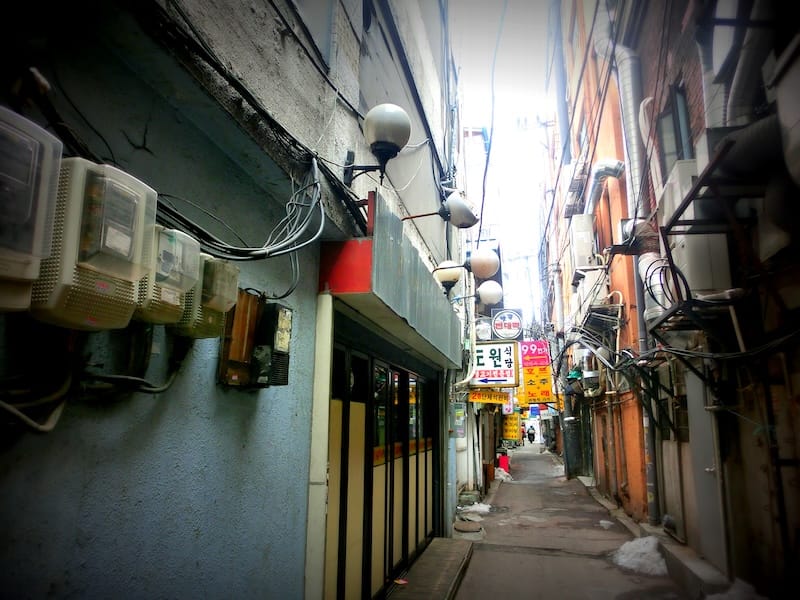
Seasonal Reasons to Return
Spring (April) – The hanok’s courtyard azaleas blossom; limited-time cherry-blossom tea appears on the chalkboard menu.
Monsoon (late June) – Rain drums on the tiled roof, amplifying that cozy, cave-like vibe; try smoky danggwi-cha (Angelica root) to banish the damp.
Chuseok Holiday (Sept/Oct) – Staff wear hanbok, and you’ll receive a miniature songpyeon (half-moon rice cake) alongside your order.
First Snow (usually Dec.) – Floor heaters crank up; order cinnamon-laced ** sujeonggwa** and watch flakes settle on the papered window lattice.
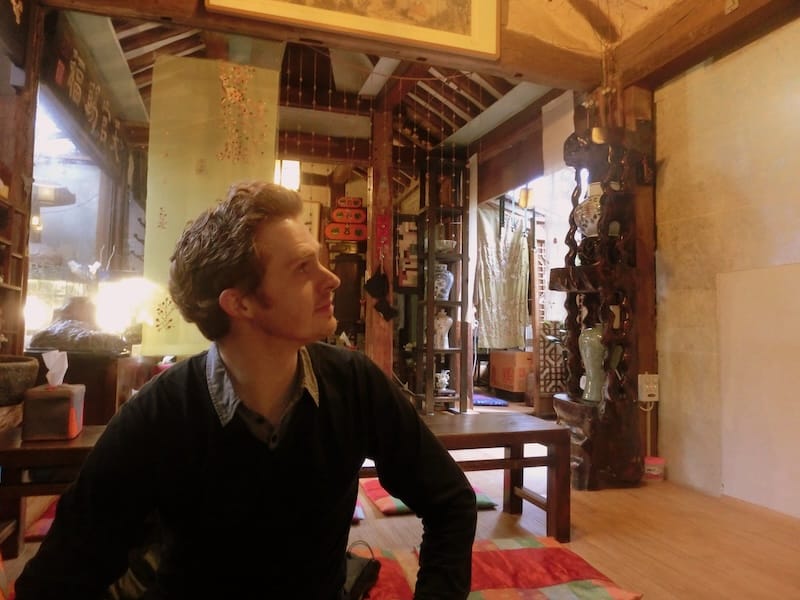
Alternatives When Shin Is Packed
Insadong has morphed into café central, but authentic hanok tea rooms remain if you know the alley map:
Tteuran (뜰안) – Hidden behind a persimmon tree, they specialise in persimmon-leaf tea and bamboo-leaf bingsu.
Moonbird Only Thinks of the Moon (달새는달만생각한다) – Quirky name, creaky staircase, fantastic pine-needle tea and homemade injeolmi (roasted-soybean rice cake).
Dawon – Inside the Kyung-In art complex; sit on the veranda overlooking lotus pots while sampling five-flavour omija punch.
While coffee chains have exploded (Seoul now has more cafés per capita than Seattle), traditional tea houses anchor a slower rhythm. UNESCO recently listed “traditional Korean tea-making” on its Intangible Heritage watchlist, and spots like Shin are living classrooms. When you swirl the copper kettle, you’re literally stirring centuries of ceremony dating back to the Goryeo Dynasty’s royal darye (tea etiquette).
So fold your legs, wrap your fingers around that porcelain cup, and let the steam fog your glasses. Seoul will wait outside. Right now, it’s just you, the tea, and eighty quietly magnificent years of history.
FAQs: Shin Old Tea House (신옛찻집), Insadong
What is Shin Old Tea House like inside?
A cozy hanok tea room with heated floors, low tables, silk cushions, dim lighting, and eclectic vintage décor—perfect for a quiet, traditional pause.
Where exactly is it in Insadong?
From Anguk Station (Line 3) Exit 6, walk to Insadong-gil 33 and turn right into the second alley after Ssamziegil. Look for a faded blue postbox near the entrance.
Do I remove my shoes?
Yes. Shoes off at the threshold; step onto the wooden floor and cushions. Socks are fine.
Is there an English menu?
Yes. The laminated English list covers house favorites, but you can also ask for traditional picks like maesil-cha (plum), saeng-gang-cha (ginger), ssanghwa-cha, omija-cha, and hyeonmi-nokcha.
What did you order—and what snacks come with it?
We had plum tea and ginger tea, served with sticky rice cakes and puffed rice—a classic, lightly sweet pairing.
How much does it cost?
Typical teas run ₩8,000–₩12,000. Pots are usually refillable with hot water on request.
What’s the etiquette and vibe?
Soft voices, slow sipping, and unhurried time. If you top up a friend’s cup, use a two-handed pour. It’s calm enough that you’ll instinctively whisper.
Do they take cards or cash only?
They accept international cards, but keep a little cash for convenience.
When is the best time to visit?
Weekday mornings are the most serene. On weekends after 4 p.m. you may queue 10–20 minutes.
Any seasonal specialties?
Yes—think cherry-blossom tea in spring, cozy ssanghwa or sujeonggwa (cinnamon-persimmon punch) in winter; monsoon days are especially atmospheric under the tiled roof.
Are there similar tea houses nearby if it’s full?
Try Tteuran (뜰안), Moon Bird Does Think of Only the Moon (달새는달만생각한다), or Dawon inside Kyung-In Museum’s garden.
What else can I pair with this stop?
Browse Ssamziegil, wander to Jogyesa Temple, pop into Kyung-In Museum of Fine Art, and snack on street hotteok or dragon-beard candy along Insadong-gil.

Looks like a cozy place indeed!
I love a good cup of tea. It always soothes me, somehow. Haven’t had the chance to go to a traditional (here’s the word) tea house yet, but it’s definitely on the bucket list!
And that was my first ‘traditional’ tea house after a year in the country… 😉
Aww, that sounds so lovely! Wish you’d posted this just a few days sooner as I was just in Insadong last week and would’ve loved to check this out. Oh well, just an excuse to go back to Seoul for a visit. 🙂
Aw, that’s a shame! But it gives you a great reason to come back to the city. 😉 I also wish I’d found it sooner – it’s the kind of place that is worth revisiting.
A nice one. I would love to have one of those sticky rice cakes. And sweet plum tea too!!! Looks like a very relaxing place.
They sure had some good rice cakes! It was a nice little hangout for a winter afternoon. 😉
Lovely place, looks very cozy!
Unrelated but I love your ring on the first pic. I had to say it.
Thanks! My aunt actually made that ring for me. I really like it too! 😀
Looks like a great place to spend a few hours relaxing. At the moment I’m spending my afternoons going theoguh he different coffees of Indonesia, instead of teas. If I ever get around to visiting Korea I could happily do the reverse.
Nico recently posted The restaurant where Big Gay Al meets Alice in Wonderland
What a cute place! Looks like the perfect location to spend a freezing winter afternoon!
It really was! Especially with the heated floors – I didn’t want to leave.
I love it! Sometimes the simplest things, like warm tea and comfy pillows, bring about the best experiences.
What a beautifully written post, a treat to read! A nice homage to your home for the last year…
Looks like a spot worthy of repeat visits. Cozy and inviting… would be difficult to leave it.
How adorable! It’s my dream to go to an authentic tea house!
Tea houses are just my absolute dream places to go to. This places looks so magical – I can’t blame you for wanting to whisper. You set the scene so perfectly. <3
It sounds like a perfect, cozy place to reminisce and chat about future plans. You’re right, sometimes the best places are literally just down the street 🙂
Cheers.
I would love to go to a proper tea house. I went to one in China once, but it was with a tour group and everythign was so fake and touristy. And of course in the end they asked us to buy some tea. Can’t wait to read about your adventures in Malaysia. I love that country!
Hi Audrey! Thank you very much for your blog and vlog! I’m planning a trip to Seoul now and your posts really help and give me new ideas on how to spend my time in Korea. If you’ll ever by any chance come to Moscow maybe I could repay you with some ideas too :))
Glad to hear it, Katya! I hope you’ll have a wonderful time exploring Seoul.:)
Hey, Audrey!
Appreciate this article on Shin Old Tea House. Like your style of casual and leisure writing.
Reminds me of the travelogue articles featured in National Geographic magazines. Absorbing descriptive essays with just enough relevant photos.
A picture may speak a thousand words. But still written words are vital and necessary to present the wonderful travel experience.
Happy travelling!
We are here right now reading your blog post waiting for out tea and rice cakes!